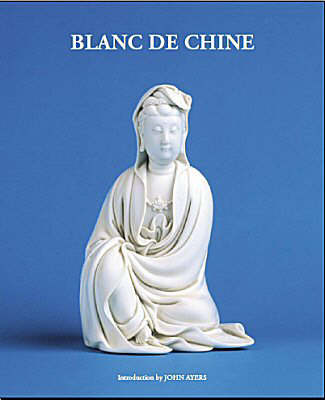"Blanc De Chine" celebrates blanc de chine porcelain from several important collections that featured in a selling exhibition at S Marchant and Son, London, in November 2006 and features a scholarly introduction to the subject by John Ayers. The collections featured include: The Arens Collection; Commander T. M. Blake; Henry Brown; Alain de Botton; The Domenech collection; Elizabeth Gibson Holahan; Chase Gilmore; Paul-Marie-Louis Guilbert; Professor E. T. Hall; John Kaye; Carl Kempe; The H. M. Knight collection; Mr E. G. Kostolany; Lucien Lelong; The Pratt collection; The Stark family collection; The David Style collection; Lord Sufoeld; and, Mr C. A. Weissing and Mrs C. Woodburn. Ayers notes that the charm of blanc de Chine, however, does not reside only in its distinguished figure models. While the best of these were undoubtedly made preeminently as devotional images for placing in shrines, there was throughout the late Ming and early Qing periods an abundant output of more useful everyday wares for the home. There are certain items, notably oil lamps, joss-stick holders and incense burners, that may equally have been intended as adjuncts to devotions.
These last, it will be noted, come mainly in shapes of archaic distinction - the ding, lien and gui forms of ancient bronzes, while signiocantly, there are gu vases which invite comparison with examples that were found in the tomb of the Wanli emperor (1579-1619): one of the few clear instances, it may be remarked, that we have of the distribution of blanc de Chine to other parts of China. It is the creative variety, as well as the sheer porcelain quality of so much of the 17th century output that endears these wares to the present-day collector, as it did to the ever-curious Augustus, who evidently sought to assemble examples of every known form. The growth of scholarly pursuits encouraged by the prosperity of the region was met by luxurious items for the writing table such as waterpots and droppers in numerous forms, brushpots, seals, and boxes suitable for seal vermilion, all of which are to be found here.
Brushpots are by their nature inclined to be rather plain and cylindrical, deriving as they mostly do from sections of bamboo; but when executed in the onest glazed cream-white ware they include some of the most desirable of porcelain items, not least when they are inscribed on the side with an incised poem: but even more when, as in the case of No.81A, we are informed that this is followed by a cyclical date (corresponding, as we must believe to the year 1612, rather than to 1672 AD) and a signature. No less admirable are the limited range of vases in shapes typical of the 17th century such as rolwagens, gu, and bottles entwined with dragons, and the great variety of table wares - tea and wine pots, and above all, cups, shaped in many cases after oowers and sometimes with applied decoration of moulded blooms, which are as delightful to hold and use as they are to look at.
- ISBN10 1872843948
- ISBN13 9781872843940
- Publish Date 1 November 2006 (first published 1 December 2002)
- Publish Status Active
- Publish Country GB
- Publisher EAPGROUP
- Imprint Eastern Art Publishing
- Format Hardcover
- Pages 156
- Language English
